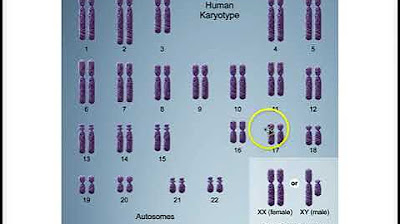DNA: Estrutura - Aula 09 - Módulo 1: Bioquímica - Prof. Guilherme
Summary
TLDRThe video explores the structure of DNA, explaining key concepts such as the double helix, nucleotide components, and base pairing rules. The instructor emphasizes the importance of understanding the anti-parallel nature of DNA strands, hydrogen bonds between nitrogenous bases, and the role of purines and pyrimidines. Additionally, the lesson covers Chargaff's rules, which help predict DNA composition. The video is designed to reinforce fundamental biochemical processes and provides practical tips for interpreting DNA structure, especially for students preparing for exams.
Takeaways
- 🐕 The dog, Balu, is present during the lecture, adding a personal touch to the teaching session.
- 🧬 The lecture is focused on the DNA structure and its importance in biochemical processes related to nucleic acids.
- 🌀 DNA is represented as a double helix, with antiparallel strands that are complementary to each other.
- 🔗 The nitrogenous bases (adenine, thymine, guanine, cytosine) form pairs through hydrogen bonds: A-T with two bonds and G-C with three bonds.
- 🎢 DNA strands run in opposite directions (5' to 3' and 3' to 5') and are called antiparallel, crucial for understanding genetic replication.
- 💡 Only one strand of the DNA serves as the template for protein synthesis, while the complementary strand provides stability and aids in replication.
- 🔥 The stability of DNA depends on the proportion of GC pairs, as they are harder to separate due to their three hydrogen bonds compared to AT pairs.
- 📏 Nucleotides in DNA consist of a phosphate group, a pentose sugar, and a nitrogenous base, with the sugar's carbons numbered for structural reference.
- 🔗 The bonds between nucleotides in the DNA backbone are called phosphodiester bonds, forming the structure of the DNA helix.
- 🔬 Chargaff's rule states that the proportion of adenine equals thymine, and guanine equals cytosine, maintaining a balanced DNA structure.
Q & A
What is the main topic of the lesson discussed in the video?
-The main topic of the lesson is the structure of DNA, focusing on its biochemical properties and its role in processes related to nucleic acids.
What is the significance of the DNA alpha-helix structure mentioned in the video?
-The DNA alpha-helix is a representation of the double helix structure of DNA, where the helical shape encodes genetic information. Its twists and turns help in maintaining the structure while allowing for stability and the proper storage of genetic information.
How do the DNA strands communicate, and what are nitrogenous bases?
-The two DNA strands communicate through nitrogenous bases, which are part of nucleotides. These bases form hydrogen bonds between the complementary strands, specifically adenine pairs with thymine, and guanine pairs with cytosine.
What does it mean when DNA strands are described as antiparallel?
-Antiparallel means that the two DNA strands run in opposite directions: one strand goes from 5' to 3' and the other from 3' to 5'. This arrangement is critical for the processes of DNA replication and transcription.
Why is one DNA strand considered a template and the other complementary?
-One strand serves as a template for protein synthesis, while the other is complementary, ensuring the stability of the DNA molecule and aiding in the creation of new DNA strands during replication.
Why is the adenine-thymine pair considered weaker than the guanine-cytosine pair?
-Adenine and thymine are connected by two hydrogen bonds, while guanine and cytosine are connected by three hydrogen bonds. The additional bond in GC pairs makes them more stable and harder to break apart compared to AT pairs.
What is the role of hydrogen bonds in the DNA structure?
-Hydrogen bonds connect the nitrogenous bases between the two strands of DNA. These bonds help stabilize the DNA structure, allowing it to maintain its helical shape while being flexible enough for replication and transcription.
What is the significance of Chargaff's rule in DNA structure?
-Chargaff's rule states that the amount of adenine in a DNA molecule is equal to the amount of thymine, and the amount of guanine is equal to the amount of cytosine. This 1:1 ratio helps maintain the double helix structure and is crucial for accurate DNA replication.
How do the nucleotides within a DNA strand connect to form the backbone of the molecule?
-Nucleotides in a DNA strand are connected by phosphodiester bonds, which link the phosphate group of one nucleotide to the sugar (pentose) of the next. This forms the sugar-phosphate backbone that supports the DNA structure.
How can you calculate the proportion of nitrogenous bases in a DNA molecule if given the percentage of one base?
-If the percentage of one base is known, you can deduce the percentages of the other bases. For example, if adenine is 13%, thymine will also be 13% due to complementary base pairing. The remaining percentage (100% - 26%) is divided equally between cytosine and guanine.
Outlines

Этот раздел доступен только подписчикам платных тарифов. Пожалуйста, перейдите на платный тариф для доступа.
Перейти на платный тарифMindmap

Этот раздел доступен только подписчикам платных тарифов. Пожалуйста, перейдите на платный тариф для доступа.
Перейти на платный тарифKeywords

Этот раздел доступен только подписчикам платных тарифов. Пожалуйста, перейдите на платный тариф для доступа.
Перейти на платный тарифHighlights

Этот раздел доступен только подписчикам платных тарифов. Пожалуйста, перейдите на платный тариф для доступа.
Перейти на платный тарифTranscripts

Этот раздел доступен только подписчикам платных тарифов. Пожалуйста, перейдите на платный тариф для доступа.
Перейти на платный тариф5.0 / 5 (0 votes)






